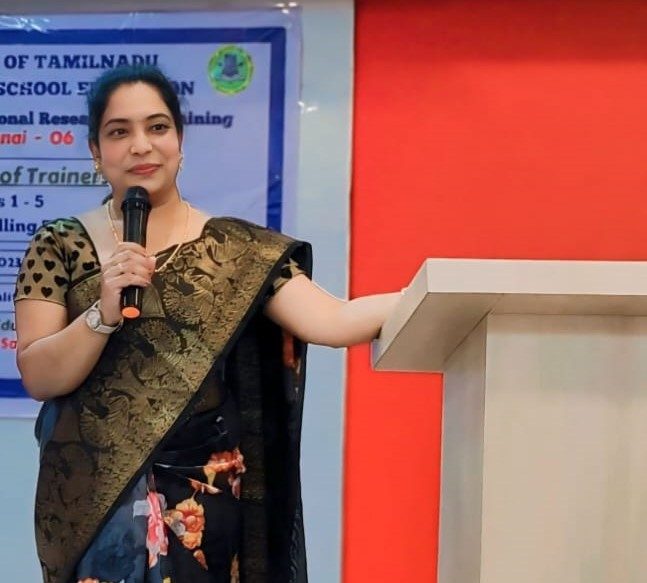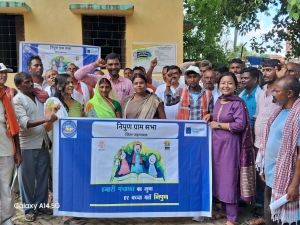In today’s rapidly evolving educational landscape, the role of effective Teaching and Learning Materials (TLM) has become more crucial than ever. Materials, such as beads or number cards, are not just supplementary aids but essential components of a holistic educational approach. They help bridge the gap between theoretical knowledge and practical application in the classroom, making learning more tangible and accessible for students at all learning levels.
In a recent interview with Christina Sara, a dedicated Secondary Grade Assistant Teacher (classes 1-3) at Panchayat Union Middle School in Melcowhatty, Ooty Block, The Nilgiris, we hear on her teaching journey, the evolution of classrooms over the past five years and the pivotal role of teaching and learning materials in her pedagogy. Her insights provide a valuable perspective on how these materials enhance the learning environment and contribute significantly to students’ academic growth and personal development.

Assistant Teacher – Secondary Grade, Panchayat Union Middle School,
Melcowhatty, Ooty Block, The Nilgiris, Tamil Nadu
Q1. Tell us about your teaching journey along with some interesting anecdotes that you may want to share.
Teaching is not just a job for me, it is a passion that I have been pursuing for the last 15 years. As a secondary grade teacher, I always try to bring innovation and creativity to my classroom. I believe that learning should be fun and engaging for children, which is why I keep my classroom attractive and interactive.
When I enter my classroom, I become a child myself. I try to understand the needs of my students and teach them in a way they can easily grasp concepts in. My classroom is not just a place to study, it is a place where children explore and learn new things.
I take pride in saying that my classroom is one of our district’s most attractive and innovative classrooms. The officials have observed my classroom several times and have praised my efforts for it. They even picked me as a resource person for our district, which was a great honour. .
I believe that teaching is not just about imparting knowledge but about creating an environment where children can learn and grow. That is what I try to do for my children in my classroom.
Q2. In your experience, how have classrooms changed over the last five years?
We all have seen tremendous transformations in classrooms over the years. There are classroom corners for puppetry, reading , storytelling, music, art and craft, quizzes and other activities. This is the speciality of modern classrooms since the launch of the Ennum Ezhuthum Mission.
This new approach to learning has transformed traditional classrooms into engaging and interactive environments. Students are no longer confined to their desks but are encouraged to explore and learn through engaging and experiential methods. .
The puppetry corner allows students to express themselves creatively by using puppets to tell stories or act out scenes. The reading corner provides a quiet space for students to read and immerse themselves in books. The storytelling corner encourages students to share their own stories and experiences with their friends.The music corner is a fun way for students to explore new songs and improve their language skills. The arts and crafts corner allows students to explore their creativity with colours. The quiz corner challenges students to test their knowledge on various topics of interest. Finally, the activity corner provides a space for students to engage in physical activities like yoga or dance, promoting physical fitness and well-being.
Different spaces like these in modern classrooms have revolutionised the way we teach and learn. It is no longer just about rote learning but also about exploring and discovering new things in a fun and engaging way.
Q3. What role do teaching and learning materials play in contributing towards improving the learning environment for children in the classroom?
TLMs help children to learn easily and joyfully in the classroom, especially in primary grades. Unlike printed materials, teaching and learning materials can teach complicated subjects in a simple and interactive learning environment for children.
By using TLMs, teachers can create a hands-on learning experience that caters to different learning styles. Visual aids like pictures, videos and interactive games can help students understand complex concepts with ease.
Additionally, these materials also help improve retention and recall. When students are actively engaged in the learning process, they are more likely to remember what they have learnt and apply it to real-life situations.
Overall, teaching and learning materials are an essential tool for teachers in the primary sector. They provide a fun and interactive way for children to learn while helping them retain information better.
Q4. How have you been able to adapt your teaching style to the TLMs?
This is something really important in the world of teaching – adapting to different techniques and materials. As an educator, it is crucial to be able to adjust your teaching style based on the content you are working with. The adaptation is made easy with the Ennum Ezhuthum Teacher’s Handbook. It is an invaluable tool in the Ennum Ezhuthum (EE) classroom. It provides comprehensive guidance that supports effective teaching, eventually enhancing student learning.
Along with a structured framework and ready-to-use resources, it also provides guidance on how to adapt and create additional materials tailored to the specific needs of my classroom. The integration of digital tools and resources enriches the learning experience and makes the lessons more dynamic.
On the other hand, the transition from regular books to using TLMs was not difficult for me because I try to approach each new material with a fresh perspective and I am not afraid to experiment with different teaching methods until I find what works best for my students. It is very important to listen to your students and be responsive to their needs. Everyone learns differently, so it is essential to be able to adapt your teaching style to meet the needs of each student.
Ultimately, being able to adapt to different teaching techniques and materials requires confidence and professionalism. You need to be willing to take risks, try new things and always put the needs of your students first.
Q5. How do you see students responding to TLM? Are they helping them learn at grade-level?
I can confidently say that children adore them! Learning materials help children learn quickly and effectively. They even help weaker students in their peer groups, which is amazing to see.
The Ennum Ezhuthum scheme has allowed children to learn joyfully through acting out stories, singing and dancing. It is incredible to witness the progress they make and the sheer joy they experience while learning. Children put their learning to use through levelled workbooks that are scaffolded, enabling them to learn better with each activity.
Overall, I truly believe that teaching and learning materials are helping students learn at grade-level and beyond.
Q6. What is your vision for your students’ future and what do you think will encourage them to achieve it?
First and foremost, when my students complete their primary education, I want them to be able to read, write and speak language fluently and confidently. This is such an important skill to have in today’s globalised world and I believe it will open up many opportunities for them in the future.
But it is not just about mastering the language – I also want my students to be able to communicate effectively and confidently. That is why I make sure to train them in expressing the language the right way.
I even encourage my students to be more participative in debates in order to strengthen their communication and speaking skills.
As a teacher, my ultimate goal for my students is to help them reach their full potential, eventually enabling them to achieve their dreams. I believe with the right tools, they will be well on their way to success.



